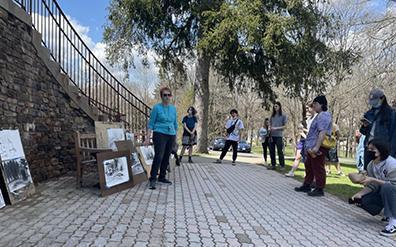"Sensing Nature" exhibition in Scholes Library builds on Art History Professor Hope Childers’ class Landscape across Cultures

Building on a semester of research and collaborative work, students in Professor of Art History Hope Childers’ "Landscape Across Cultures" class have put together an exhibition called “Sensing Nature,” which opened last week in the Scholes Library Project Space and features a wide variety of media, including paintings, prints, sculpture, photography. The show runs until Monday, May 30.
Building on a semester of research and collaborative work, students in Professor of Art History Hope Childers’ "Landscape Across Cultures" class have put together an exhibition called “Sensing Nature,” which opened last week in the Scholes Library Project Space and features a wide variety of media, including paintings, prints, sculpture, photography. The show runs until Monday, May 30.
The artwork grew out of students’ study of landscapes, Childers says, noting the course encouraged a broad interpretation of “landscape” as a springboard for examining land, space, place, and site in the visual arts, across cultures, geographies, disciplines, and time periods. The Scholes exhibit, Childers adds, raises numerous questions, including: What is a landscape? What is nature? What is wilderness?
“What is our relationship to these phenomena, which are both abstract concepts and realities of our world?”
“I think the most important thing I learned in the landscape class is how nature relates to history, culture, art and everything around us,” says Yitong Chen, a senior student in the School of Art and Design who participated in Childers’ class. “I never thought that these common natural materials could be presented in so many abundant and unexpected forms.”
"The most important thing this class has taught me is to be mindful of the way different people, animals, and weather have shaped the land," says student Josie Fasolino. "I've learned to really get out and observe, forage, sketch, journal, and immerse myself in nature. Your connection to the land and the people around you won't strengthen in the confines of your dorm room!"
Third-year student Cecilia Sherwood added: “[The course] guides students to understand their individual relationships with the landscape. Weekly research and discussions generate new ways of framing what a landscape can be that goes beyond sunrises over hills. … Moving forward, I plan to observe more relationships to land and use them to inform my art practice.”
Childers’ students studied canonical landscape paintings, and discussions ranged from the picturesque to the sublime; from 19th-century science to the today’s environment; from the history of U.S. settlement to the founding of National Parks; from microbiology to the cosmos; even the future of the current anthropocenic age.
The class also pushed beyond the canonical, Childers says, and included guest appearances by two local artists: Seneca storyteller, teacher, and painter Bill Crouse, who shared with the students a Ganö:nyök—a traditional greeting to nature; and artist and Alfred State College professor Tammy Renee Brackett, who took the class outside to observe the landscape in real time.
Local farmer Jerry Snyder of Sunny Cove Organic Farm spoke to students about his family’s long ties to the land and the importance of soil. Other guests included Alfred University faculty members: Professor of Environmental Studies Fred Beaudry, who spoke about ornithology and environmental science; Professor of Anthropology Robert Myers, who focused on anthropology and maps; and Clinical Assistant Professor Kathy Vajda, School of Art and Design, who took students out on a beautiful day to do some charcoal sketching.
The artwork is available for viewing during Scholes Library’s regular hours.
